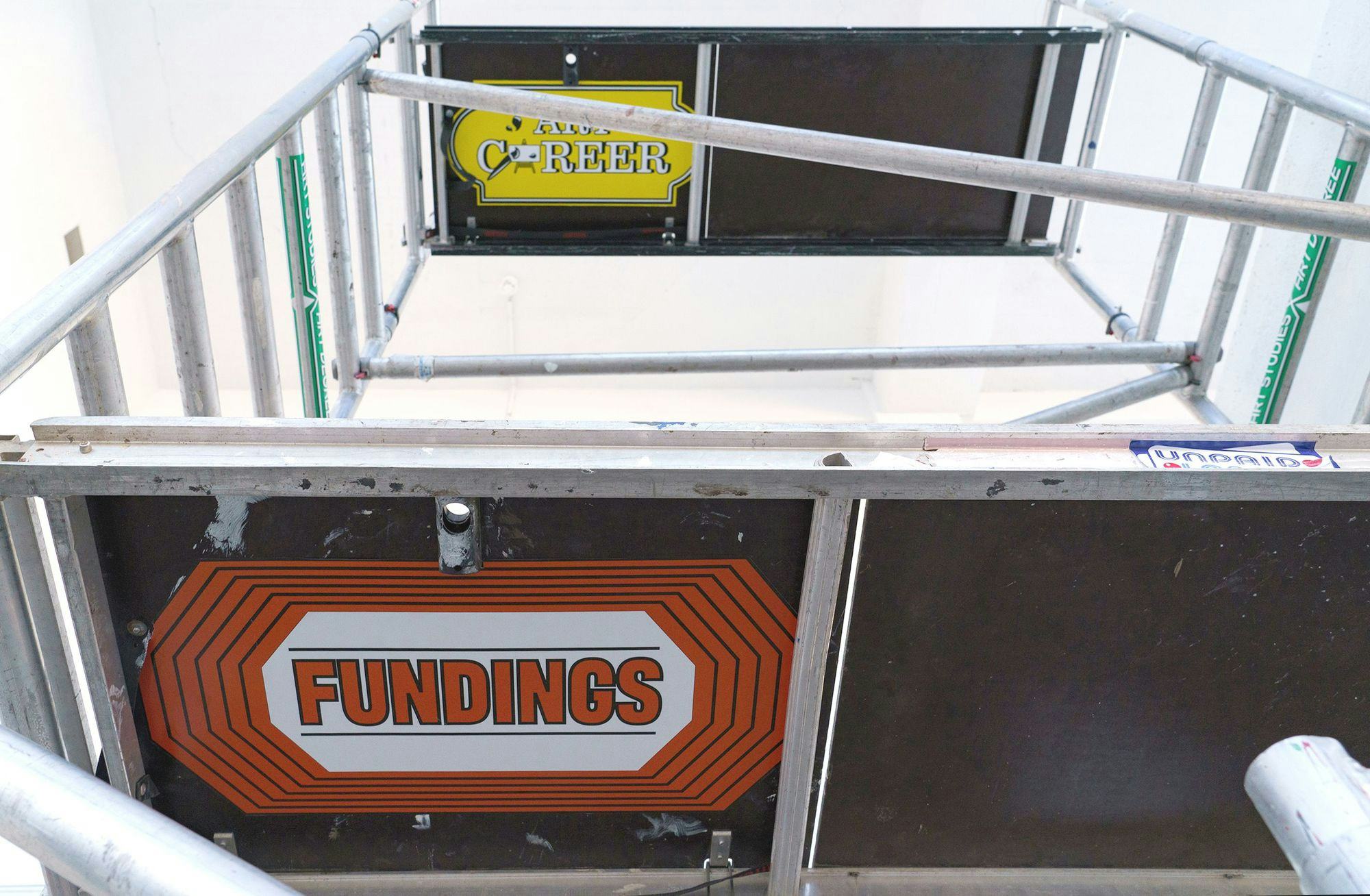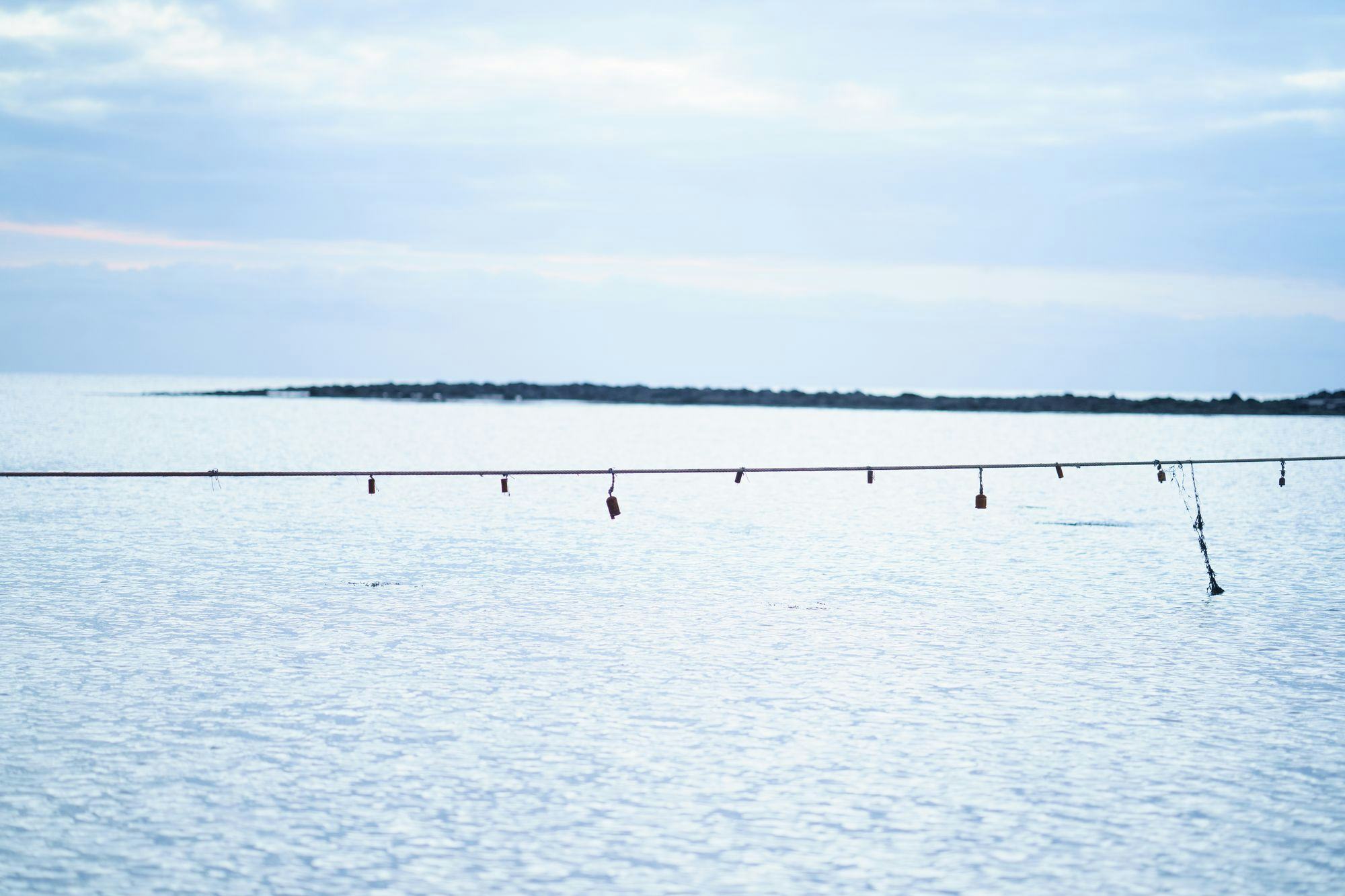The following article reflects the author’s experience visiting the exhibition Thresholds on the island La Certosa in the Venetian Lagoon. The exhibition is part of this year’s German Pavilion curated by Çağla Ilk, on view until the 24th of November. Some incidents and encounters are fictitious.
It is Monday noon when I make my way over to the island of La Certosa. Mondays are quiet in Venice. The exhibitions and pavilions of Arsenale and Giardini are closed and most restaurant and bar workers rest after busy weekends. I take boat number 4.2 to the island and as we approach the dock I go to the front to ensure I make it off in time. To my surprise, I am the only person to hop off. Unsure about my jump onto the island, I look at the boat operator, who gives me a little wave that makes me feel even more uneasy as they slowly drift off.
The metal pier to the island is unusually long and the wake waves on each side feel like they are playing a game of tug o’ war, making the walking surface unsteady. As the sound of the boat engine disappears into the distance I hear an echoing voice that draws me towards the shore. “We move through doorways too quickly.” “We move through doorways too quickly.” For a while I stand still in this transitional space and listen, holding onto the railway of the pier, and looking towards the island. No one - not a single person in sight.

There is a large unruly field with a light gravel trail that leads to a forested area in the distance. Suddenly I notice how my sense of hearing has become intensified as I start listening to my breath and footsteps (this is almost unthinkable in the bustle of Venice). With this heightened state of perception, I walk further onto the field. Then I feel its heartbeat and for a moment I seem foreign in my own body. The heartbeat travels up my body through the soles of my feet. The empty field now seems vigorous, giving the layers of the human and natural past a voice, a heartbeat. The empty field is in fact not untouched by human culture and you can feel it. Walking towards the trees, ruins of a monastery take shape and with it a high-frequency sound coming from inside its walls. There seems to be no designated way to the building since the paths are all overgrown with grass. I take long steps over the grass and enter the half-destroyed building.
Within its wooden structure and walls of red bricks I feel comfort and calmness but the acoustic spectra sounds like it’s alarming my foreign presence.
And then there she is, another visitor. I have to admit, I was startled because I had made the assumption that I was the only visitor on the island. She is completely still, fully immersed in the sound just like myself. As I slowly walk past her I can tell by her swiveled ears that she got startled as well. In the middle of the monastery ruins is a large hackberry tree, whose leaves are gradually turning yellow. I follow my ears as they guide me through the ruins until I am standing outside the building again, on the other side, overlooking Lido island. The high-frequency sound from the monastery has followed me and I somehow still feel like I am inside. Curious, I let my senses guide me further into this foreign state. Now concerned that I may have started hallucinating and that perhaps I never saw the rabbit (the other visitor) wander back to the main trail of the island.

Nicole L´Huillier, Encuentros, 2024, Photo Andrea Rosetti.
I wander into a swampy landscape, where I see a membrane hanging from a tree, it’s listening to me and perhaps has been since I hopped on the island. As I walk under the tree my skin tingles, answering the membrane without my consciousness. I walk through a tunnel of bamboo trees listening to their conversations; my skin serving as a threshold mediating meaning and understanding. The membrane seems to be not only talking to me but to all the other membranes on the island, through vibrations, we are all connected across realms.
Now, in the depths of the forest, a strong wind blows calmly. I am lost but I follow the trees until I'm there. I listen.

Jan St. Werner, Volumes Inverted, 2024, Photo Sunna Dagsdóttir.
For the first time the German Pavilion’s representation at the Venice Biennale expands from its historically fraught building in Giardini, onto the neighboring island of La Certosa. Whilst the pavilion at Giardini is packed with visitors every day, the island offers a more unique and calm setting.
The exhibition titled Thresholds shows works by six artists, four of which are discussed in this article. On La Certosa, the idea of the threshold is extended by the works of Robert Lippok, Jan St. Werner, Nicole L’Huillier and Michael Akstaller. Each of the works interacts with the island's landscape and non-human entities through various sound works, creating an intricate exploration of meaning and perception, where the visitors can experience an odyssey through acoustic phenomena.
The history of the island La Certosa dates back to 1199 when the island became a site of an Augustinian community. After two centuries, the island was given to the Carthusian community of Florence, but under Napoleon, the monks were forced to leave and the island became a military site. Today the ruins of the monastery and military bunkers still hold the religious and military history of the island. It is the second time the island has hosted a national pavilion at the Venice Biennale, the first being the exhibition titled A Bridge to the Desert by the Republic of Namibia in 2022.
This year's German Pavilion, curated by Çağla Ilk, attempts to move away from the national pavilion model by taking this outward step to La Certosa. In an interview with whitewall the curator states that ,,the significance of selecting this location lies in its role in deterritorializing the concept of national belonging. Symbolically, the island represents a departure from conventional notions of space, serving as a new pavilion that challenges hierarchical structures and architectural confines.’’
The island of La Certosa is located less than 200 meters from the Sestiere di S. Pietro and a short 10-minute vaporetto ride from the Giardini della Biennale stop. With this year's most expansive pavilion of around 22 hectares, the sound works on La Certosa offer the visitors a journey of the senses. The four sound works are installed in different locations around the island, each uniquely embedded into their surroundings:
For his work Feld (Field), Robert Lippok installed a sonic net of 12 woofers in the ground of the island, scattered in an asymmetrical field, where once the monastery buildings and later military installations were located. The booming sound plays with the perceptions of the visitors and opens up the discussion of cultivated landscapes and their continuous transformation by man.
The work Volumes Inverted by Jan St. Werner consists of two custom-made loudspeakers, one located in the ruins of the monastery and the other several hundred meters away in the surrounding lagoon. The speakers play two separate electronic sound pieces, requiring the spatial orientation of the visitors to be readjusted. In Encuentros (Encounters) Nicole L’Huillier has installed elastic membrane microphones made of silicone and piezoelectric sensors, in various locations on the island. The membranes communicate with the surroundings through a transceiver system. In his work Scattered by the Trees Michael Akstaller explores the frequency spectra of the forest and how sound transmits in certain ecosystems. His installation consists of two cones that serve as measuring instruments tuned to the frequencies that allow the visitor to hear and follow the dialogue of the ecosystem.
To further anchor the ideas of the threshold, the curator includes the spoken-word-and-electronics piece by Nigerian-born, US-based writer Louis Chude-Sokei. The work along the pier to the island emphasizes the moment of transition, the moment when one arrives, though the stage of arrival never ends.
Thresholds on La Certosa draws attention to the everyday acoustic phenomena, like the wind in the trees and chirping birds; sounds and exchanges that seem bland at first listen. The unique setting enhances the overall experience and sets a foundation for the sound works by blurring the lines between the cultural and natural. The threshold therefore is not about the arrival nor space but rather an ever-changing state of curiosity, where we listen to our environment and each other.

Robert Lippok, Feld, 2024, photo, Andrea Rosetti.
This is the eighth article about the Venice Biennale where the main themes and ideas are explored, as well as the national pavilions, the uncertainty of current events and the main exhibition, Foreigners Everywhere which is curated by Adriano Pedrosa. Newly graduated artists from Iceland University of the Arts and art theorists from The University of Iceland, interns situated in Venice, are currently working on articles and reports of key ideas and themes of current exhibitions of La Biennale.
Sunna Dagsdóttir is a curator and art historian from Reykjavík. Over the last year she has used the Erasmus+ funding for internships at Rupert Residency & Alternative Education Program in Vilnius, Lithuania and Kunsthall Trondheim in Norway.

Michael Akstaller, Scattered by the Trees, 2024, Photo: Andrea Rossetti.



-icelandic-pavilion-2000x2667.jpg&w=2048&q=80)

